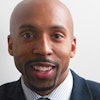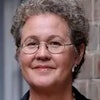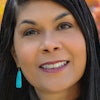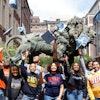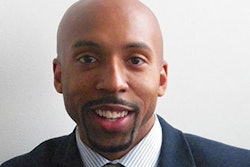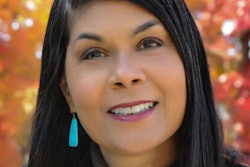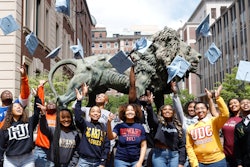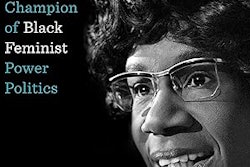When Dr. Devorah Lieberman became president of University of La Verne in 2011, a private institution of approximately 8,000 students about 35 miles east of Los Angeles, she was in many ways seeing life come full circle. At the time she was offered the position, she was the provost of Wagner College in New York City, which caused the hiring committee to ask how a New Yorker would adapt to Southern California. She informed them that, in fact, she grew up about five miles from La Verne’s main campus. Although she hadn’t lived in the area in decades, she saw it as a homecoming.
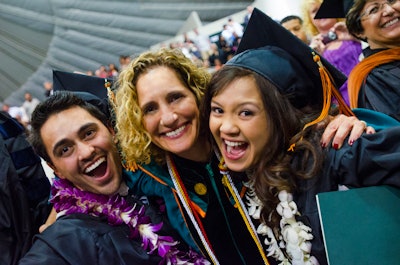 University of La Verne President Dr. Devorah Lieberman is shown with graduating students in 2013.
University of La Verne President Dr. Devorah Lieberman is shown with graduating students in 2013.
“When a culture changes, you have to stay focused on the goodness in the institution and not a few negative voices,” said Lieberman. “Anybody who’s breaking any glass ceiling has to focus on the positive.”
As the university evolved it has become increasingly diverse. It is a federally designated Hispanic Serving Institution (HSI) as well as one that celebrates many different cultures and backgrounds. Among Lieberman’s highlights is that the institution has embraced the diversity of the region. In 2015, Lieberman was named President of the Year by the Association of College Unions International for supporting an inclusive and engaged campus community.
Lieberman advocates having pride in community. “Be proud of where you’re located,” she said. “Be proud of the students who come to your institution. Be proud of the education you’re providing for those students.”
Lieberman said the university has embraced something they call the Brain Remain, which is students coming from the region, getting educated, and remaining in the region to lift their communities. She notes that U.S. News & World Report created a new category, social economic mobility, and University of La Verne ranked sixth in the country. “The number one private institution that is recruiting, retaining and graduating students who are going back to their communities … and improving their neighborhoods,” she said.
The third highlight is that the university has embraced listening to the region and what leaders in the region say they need in their graduates. “So that we graduate students who meet the needs of employers in the industries,” Lieberman said.
Having read her work and been impressed with her during the interview process, members of the board of trustees said they saw her as a president who could lead the institution to its next stage. Lieberman has written and co-authored multiple books and articles relating to diversity, institutional transformation and issues affecting higher education. Lieberman sees challenges as opportunities, so she saw to it that the institution fully embraced its HSI status, which was not initially welcomed. She is proud that HSI status is now an integral part of the institution and she is a presence nationally as a board member of the Hispanic Association of Colleges and Universities as well as being a California presence with frequent visits to Sacramento, the state capital, to weigh in on higher education issues.
“The second big challenge was we knew that if we were going to provide the scholarships that the students needed…we had to raise money for scholarships for our students,” Lieberman said. “Most of the students are middle- and low-income and first-generation. The challenge was how do we raise that money because that wasn’t part of our ethos or our culture.
“I had to stand up and say, ‘It’s OK to ask for money,’” she continued. “In the last 12 years, we’ve raised at least $170 million.”
Seeking support
Turning challenges into opportunities was part of the culture shift. Early on, the university developed a more robust advancement office and hired a consulting firm. There had never been a comprehensive capital campaign, so one was developed. Lieberman aimed to raise $125 million and achieved $128 million a year ahead of schedule.
At the start, there were no major donors making multi-million-dollar contributions, but smaller donors came through. During the COVID-19 pandemic, seven nights a week she hosted virtual dinners with donors by ordering food from the donors’ favorite restaurants and having it delivered to their homes. In May, an unnamed donor committed to the largest gift in the history of the university, $18.1 million. The donation did not come from an alumnus, said Lieberman, but it came from someone who sees how La Verne serves its students.
“I love watching the donors’ faces when they give a gift that they knew will be transforming students’ lives,” Lieberman said.
To accomplish the goals that the fundraising will enable, she sees it as essential that the faculty, staff and board work collaboratively on the visioning for the university. This includes creating new means for retention. From the start of her presidency, Lieberman worked with faculty to reimagine the university’s academic and co-curricular programs, including the creation of a Center for Teaching and Learning and the Office of Civic Engagement. She oversaw a Campus Master Plan that reflected the institution’s core values, such as diversity and inclusion.
“I came in with a concept for the undergraduates that I shared with the faculty called The La Verne Experience [that is part of the master plan],” Lieberman said. “It had to do with all freshmen taking a bundle of courses where it was more interdisciplinary and connected to the community. So, it would lead to feeling that they belong here at the university because when you’re first-generation you don’t always feel like you belong. That’s now running and stronger than ever.
“The sophomore year takes something called SoLVE (Sophomore La Verne Experience), in which [students] get much more deeply connected to career advice and the co-curricular activities happening on campus,” she continues.
Academic progress
There has also been focus on the university’s academic programs. Under Lieberman’s leadership the university consulted with industry leaders in the region about the most needed professions. As a result of those extensive interviews, La Verne created the College of Health and Community Well-Being and expanded the College of Education. The university also developed programs in data analytics, artificial intelligence, media and film as well as certificate programs. Tracks from undergraduate to graduate studies allowed students to see the career potential of various majors.
“We were very focused on not telling the region what they needed, but listening to the region for what they say they need and then adapting our educational programs to their needs,” she said. “That has been wonderful for us. Our enrollment is now going back up toward pre-pandemic levels. In the next couple of years, they’ll do an additional Master Plan, but we’ve been following what we said we needed to do with new buildings.”
Two residence halls, a dining hall and a parking structure were constructed during Lieberman’s presidency. The Randall Lewis Center for Well-Being and Research and the Ludwick Center for Spirituality, Cultural Understanding and Community Engagement were also developed.
Lieberman’s doctorate is in intercultural communication, and she has carried out that mission and will continue to do so. “My raison d’etre was to provide spaces, places and skills for people to cross lines of difference,” she said. She has gotten the campus active in interfaith activities. The Ludwick Center is a space with room for multiple religions.
“The building is a perfect example of bringing people together who have different cultures, ethnicities, religions and backgrounds,” she said. “It’s about everyone on your campus saying, ‘This is where I belong,’”
In addition to the main campus, La Verne has several regional campuses. The university is the largest single employer in the city of La Verne.
Engaging the community with the university has been thoughtful and strategic. La Verne is a small city of about 33,000, but there are nearly six million people living in the region. There is something called the president’s health advisory council with approximately 40 leading health professionals (from hospitals and health organizations) in the region, which meets regularly. Every time the College of Health and Community Well-Being holds an event, professionals from the region are invited.
“La Verne’s visibility has been raised because there are things happening at the university that impact the community,” she said.
After her presidency concludes in August, Lieberman will stay on as a part-time advisor to the new president for the next year. She and husband Roger Auerbach will remain in Southern California. One of their daughters is a professor at UCLA, and there is a grandson they look forward to visiting.
“I’m looking very carefully at where I can continue to add value in higher education,” Lieberman said. “Stay tuned.”

